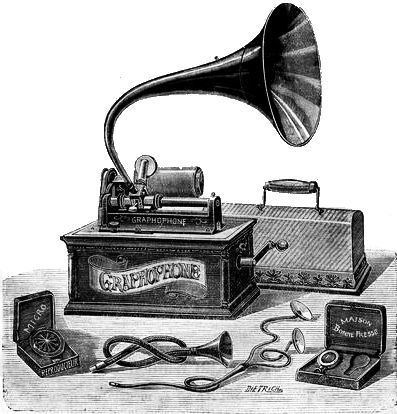 | ||
The Graphophone was the name and trademark of an improved version of the phonograph. It was invented at the Volta Laboratory established by Alexander Graham Bell in Washington, D.C., United States.
Contents
Its trademark usage was acquired successively by the Volta Graphophone Company, then the American Graphophone Company, the North American Phonograph Company, and finally by the Columbia Phonograph Company (later to become Columbia Records), all of which either produced or sold Graphophones.
Research and development
It took five years of research under the directorship of Charles Sumner Tainter and Chichester Bell at the Volta Laboratory to develop and distinguish their machine from Thomas Edison's phonograph.
Among their innovations, the researchers experimented with lateral recording techniques as early as 1881. Contrary to the vertically-cut grooves of Edison phonographs, the lateral recording method used a cutting stylus that moved from side to side in a "zig zag" pattern across the record. While cylinder phonographs never employed the lateral cutting process commercially, this was later to become the primary method of phonograph disc recording.
Bell and Tainter also developed wax-coated cardboard cylinders for their record cylinders, instead of Edison's cast iron cylinder which was covered with a removable film of tinfoil (the actual recording medium) which was prone to damage during installation or removal. Tainter received a separate patent for a tube assembly machine to automatically produce the coiled cardboard tubes which served as the foundation for the wax cylinder records. The shift from tinfoil to wax resulted in increased sound fidelity as well as record longevity.
Besides being far easier to handle, the wax recording medium also allowed for lengthier recordings and created superior playback quality. Additionally the Graphophones initially deployed foot treadles to rotate the recordings, then wind-up clockwork drive mechanisms, and finally migrated to electric motors, instead of the manual crank that was used on Edison's phonograph.
Commercialization
In 1885, when the Volta Laboratory Associates were sure that they had a number of practical inventions, they filed patent applications and began to seek out investors. The Volta Graphophone Company of Alexandria, Virginia, was created on January 6, 1886 and incorporated on February 3, 1886. It was formed to control the patents and to handle the commercial development of their sound recording and reproduction inventions, one of which became the first Dictaphone.
After the Volta Associates gave several demonstrations in the City of Washington, businessmen from Philadelphia created the American Graphophone Company on March 28, 1887, in order to produce and sell the machines for the budding phonograph marketplace. The Volta Graphophone Company then merged with American Graphophone, which itself later evolved into Columbia Records. The Howe Machine Factory (for sewing machines) in Bridgeport, Connecticut, became American Graphophone manufacturing plant. Tainter resided there for several months to supervise manufacturing before becoming ill, but later went on to continue his inventive work for many years. The small Bridgeport plant which was initially able to produce three or four machines daily later became, as a successor firm, the Dictaphone Corporation.
Subsequent developments
Shortly after American Graphophone creation, Jesse H. Lippincott used nearly $1 million of an inheritance to gain control of it, as well as the rights to the Graphophone and the Bell and Tainter patents. He directly invested $200,000 into American Graphophone, and agreed to purchase 5,000 machines yearly.
Soon after, Lippincott purchased the Edison Speaking Phonograph Company and its patents for US$500,000. He then created the North American Phonograph Company in 1888 to consolidate the national sales rights of both the Graphophone and the Edison Speaking Phonograph.
Jesse Lippincott set up a sales network of local companies to lease phonographs & gramophones as dictation machines. Lippincott invested $200,000 in the American Graphophone Company and agreed to purchase 5,000 machines per year, in return for sales rights to the graphophone (except in Virginia, Delaware, and the District of Columbia). He also bought control of Edison patents for $500,000, and exclusive sales rights of the phonograph in the United States from Ezrah T. Gilliand (who had previously been granted the contract by Edison) for $250,000, leaving Edison with the manufacturing rights.
In the early 1890s Lippincott fell victim to the unit's mechanical problems and also to resistance from stenographers, resulting in the company's bankruptcy. This would postpone the popularity of the Graphophone until 1889 when Louis Glass, manager of the Pacific Phonograph Company would popularize it again through the promotion of nickel-in-the-slot 'entertainment' cylinders.
In 1889, the trade name Graphophone began to be utilized by Columbia Phonograph Company as the name for their version of the phonograph. Columbia Phonograph Company, originally established by a group of entrepreneurs licensed by the American Graphophone Company to retail graphophones in Washington DC, ultimately acquired American Graphophone Company in 1893. In 1904 Columbia Phonograph Company was established in Toronto, Canada. Two years later, in 1906, the American Graphophone company was reorganized and its name was changed to Columbia Graphophone Company to reflect its association with Columbia. In 1918, Columbia Graphophone Company was reorganized to form Columbia Graphophone Company - retailer and Columbia Graphophone Manufacturing Company - manufacturer. In 1923, Luis Sterling bought Columbia Phonograph Co. and reorganized it yet again, giving birth to the future record giant Columbia Records.
It is important to note that early machines compatible with Edison cylinders were modified treadle machines: the upper-works attached to a spring or electric motor (a Type K electric) in a boxy case, which could record and play back the old Bell and Tainter cylinders. Some machines, like the Type G, used new upper-works, which were not designed to play Bell and Tainter cylinders. The name Graphophone was used by Columbia (for disc machines) into the 1920s or 1930s, and the similar name Grafonola was used to denote internal horn machines.
